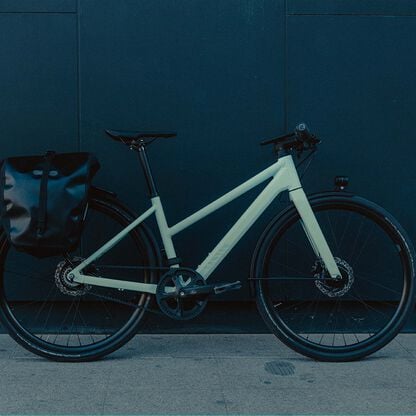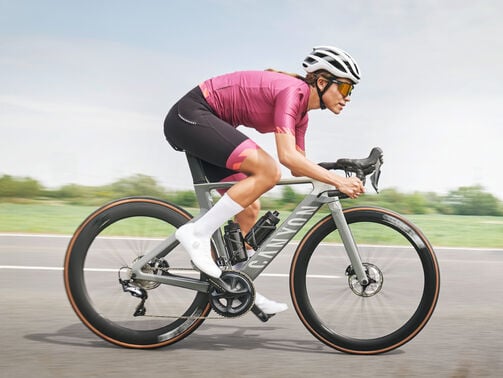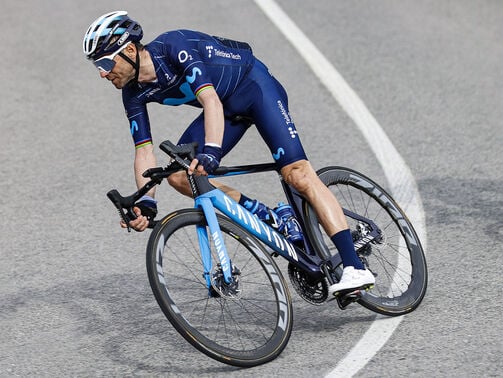City bike vs road bike: Differences and similarities
City bike vs road bike: which is right for you? Whether you’re leaning towards the performance edge of a road bike or the functional machine that is the city bike, let’s take a closer look at how these two models measure up.

.jpg?sw=503&sfrm=jpg&q=80)
Dream of gliding through bustling city streets or racing down open roads with the perfect bike beneath you? City bikes provide comfort and practicality for navigating urban landscapes, while road bikes deliver exhilarating speed and performance.
City bikes and road bikes offer a unique riding experience that promises to enhance any journey. Read on to learn about the unique features of each and choose the right one for your lifestyle.
Contents
The purpose behind the bike types
Road bikes are lightweight, aero machines engineered for optimal performance on smooth asphalt. All about speed and efficiency, their target is to be the quickest bike possible. Riders love them for long rides, races or frequent workouts. The term “road bikes” is quite broad and includes various classes such as aero, race, cyclocross, and triathlon bikes. Learn more in our Road Bike Buyer’s Guide.
City bikes, on the other hand, give urban explorers all they need to manoeuvre the streets. Also known as commuter bikes, city bikes are made for inner-city riding and short-distance commutes. Whether you load them up with groceries or zip by traffic on your way to work, city bikes are designed to be the ultimate urban companion. Find out more about their strengths in our City Bike Buyer’s Guide.
Key differences between road vs city bikes
Compared to a city bike, the road bike has a much higher performance ceiling. There’s a noticeable speed difference between the two bike styles with the same power output.
The performance gains you’ll get from a city bike over a commuter bike come down to a few key factors:
- Weight: Road bikes are lighter than commuter bikes due to their frame weight and thin tyres, giving them a better power-to-weight ratio and faster speed.
- Aerodynamics: Road bikes are designed to be more “aero” than commuter bikes. The frame shape and rider position over the handlebars make your body more efficient at top speeds. If you’re looking for a bike that competes at the same level as the pros and delivers unmatched speed, take a look at what an aero bike can do.
- Gearing: Road bikes have more aggressive gearing designed for higher top speeds.
- Tyres: Road bikes have slimmer tyres and lighter wheels than a city bike
A city bike is designed to get you to your destination in comfort. Straight handlebars, wider saddles and other ergonomic details ensure you remain at ease for longer.
- Designed for the city: With a more upright rider position for visibility, city bikes are designed for an urban environment.
- Functional: With space for panniers, mudguards, chain guards and even lights, city bikes are built for riding around traffic and daily journeys.
If you’re looking at longer-distance rides, the road bike’s extra speed and performance will add up. With straight handlebars, wider saddles and other ergonomic details, city bikes are designed to handle the rigours of urban riding. These bikes often have a suspension system to soften bumps and vibrations.
Road vs city bike geometry
Geometry is about how a bike's frame is formed, how it positions the rider and the measurements between key points on a bike.
A road bike’s geometry is more aggressive and performance-driven. The rider’s back is angled lower, closer to the bike, making it more aerodynamic. The handlebars and pedals are positioned in a place oriented towards speed.
The weight of a bike’s frame also plays a part. While it depends on the model, it’s not unusual for a road bike to be at least a kilogram lighter than a commuter bike.
City bikes are designed for frequent, short rides through flat urban areas, focusing on comfort and visibility. Their geometry emphasises manoeuvrability to navigate traffic efficiently. An upright riding position enhances both comfort and visibility, making it easier to negotiate city streets and remain aware of surrounding traffic.

City bike vs road bike: riding style
Compared to a city bike, a road bike allows you to ride significantly faster with the same effort. It positions the rider to generate more power without tiring as quickly, resulting in an improved average speed. More agile and fun, it's hard not to want to push yourself on a road bike, taking corners faster and speeding down hills.
However, the commuter bike excels in comfort. It offers a relaxed riding position, increased visibility in stop-and-go traffic and a larger, cushioned seat. Extra features like mudguards and lights can add some weight, but city bikes are generally built tougher to withstand the demands of urban life.
Handlebars: drop bar vs flat bar comparison
A road bike is designed to go distances with as much efficiency as possible. Drop bar handlebars, which curve downwards, keep the rider learning forward and closer to the bike. As well as reducing drag, this position allows your legs to put more force into the pedals.
The drop bars on a road bike have multiple hand positions, allowing you to adapt to the terrain and stay comfortable on sweeping corners or uphill inclines. City bikes almost always have flat bars, providing the rider with just one hand placement option. Some riders find drop bars uncomfortable, and the forward-leaning riding style of a road bike requires more flexibility. Many find flat bars easier and more comfortable to use.
Wheels and tires
Differences in wheels and tyres reflect the distinct purposes of each bike type: city bikes prioritise comfort and durability for everyday use, while road bikes focus on speed and efficiency for athletic performance.
- Width and size
A city bike typically has wider tyres, ranging from 30 mm to 40 mm. Wider tyres provide better grip and comfort on uneven urban surfaces like potholes and cobblestones.
Road bikes have skinnier tyres, usually between 25 mm and 28 mm. This width reduces rolling resistance and increases speeds on smooth, paved roads.
- Durability and tred
City bikes are designed for robustness and longevity to withstand the wear and tear of daily commuting. They feature reinforced rims to handle impacts from curbs and rough city roads. Lower tyre pressure helps absorb shocks from uneven surfaces, and a lightly treaded pattern balances speed and grip on various city surfaces.
In contrast, road bikes have higher tyre pressure to improve speed and minimise rolling resistance, but this makes the ride less comfortable on rough surfaces. Their smoother or slicker tyres minimise contact with the road, offering less grip on loose surfaces or when wet.

Brake mechanisms
Canyon road bikes typically feature hydraulic disc brakes, offering superior stopping power, consistent performance in all weather conditions and better modulation than traditional rim brakes.
While disc brakes are becoming the standard for road and commuter bike types, rim brakes remain an option for those prioritising a lighter bike and easier maintenance.
Gearing systems
Built for speed, road bikes are designed to propel you forward with every pedal stroke. They shed weight by using two chainrings in the front (some city or hybrid bikes might have three). Gears are selected to maintain optimal cadence at high speeds and adapt to inclines and declines.
A city bike won’t have the top-end gears seen on road bikes. Despite this minimal gearing, efficient drivetrains still allow urban riders to conquer the hilliest of city roads.
Some city bike models use belt drives instead of traditional chain drives. A belt drive is low-maintenance, requiring no lubrication and offering a longer lifespan compared to conventional chains. It operates more quietly and smoothly, providing a more reliable riding experience, especially suited for urban commuting.
Racks and mudguards
City bikes usually come equipped with fenders (mudguards), luggage racks and low-maintenance parts as standard, often including integrated lights. These features add some weight but enhance practicality, providing protection from splashes and the ability to carry cargo easily.
For commuters, added accessories mean a more comfortable, versatile and convenient ride compared to road bikes, which prioritise speed and lightweight design. Road bikes typically lack the necessary mounts and bolts for these accessories, making them less suitable for practical, everyday use.

City bike vs road: How to make the right choice?
Choosing between a city bike and a road bike depends on your riding needs and environment.
- Terrain and comfort: If you're navigating poorly maintained city streets with cracked asphalt, a city bike offers a more comfortable ride, absorbing bumps better than a road bike. But, if your route is mostly smooth asphalt and you crave speed and agility, a road bike provides a more exhilarating ride.
- Cargo and commute: For carrying work gear, groceries or dealing with stop-and-go traffic, a city bike with built-in racks and panniers is ideal. If your commute involves many hills, you might even want to consider an e-bike for added ease and efficiency.
- Clothing and Fitness: City bikes allow you to ride comfortably in regular clothing, while road bikes often require more specialised cycling attire for comfort. If you want to push for distance at speed, get fitter or even have aspirations of road riding in a group, a road bike might be for you.
- Hybrid Option: Hybrid bikes offer a middle ground, combining the speed of road bikes with the comfort of city bikes. Models like the Canyon Roadlite feature relaxed geometry, flat handlebars and wider tyres for versatility and comfort on various terrains. To see how hybrid models stack up against each other, check out our detailed comparison of the Pathlite vs. Roadlite.
Other model ranges, like the Endurace, have less aggressive geometry and wider tyres than a road bike. They are sportier than a city bike, with drop handlebars and a
more aero body position. For a broader comparison, take a deeper look at city bikes, such as the Commuter and the Precede:ON.
Ultimately, a city bike is practical and comfortable if you face bad roads and need to carry cargo. If speed and distance on smooth roads are your priorities, a road bike might be the better choice. Seeking something in-between? A hybrid bike can offer the best of both worlds!
Can you use a road bike as a commuter?
Road bikes can make great commuter bikes. They are lightweight and fast, allowing for quick travel across long distances. Their gearing is designed to handle various inclines and declines efficiently.
However, road bikes lack built-in features like racks, mudguards and lights, so you'll need to add these accessories for added practicality and comfort in daily commuting.
When choosing between a road vs city bike, the best bike for you is one that makes your ride enjoyable and meets your specific commuting or recreational needs. So, choose wisely and enjoy the ride.
Discover our Hybrid Bikes
Did this article help?
Thank you for your feedback
-
 About the author
About the authorKimberly Hobson
Get to know Kim Hobson, a digital marketer and copywriter with a passion for the outdoors and all things on wheels.










